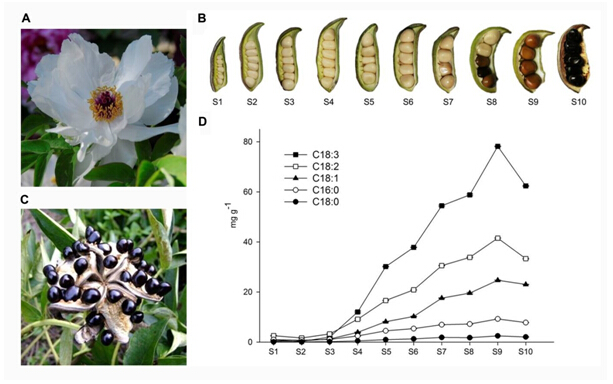Tree peony, belonging to the section Moutan and genus Paeonia, has been identified as novel resources in March of 2011. It contains dark oval seeds characterized by abundant unsaturated fatty acids and a high proportion of n-3 fatty acids. The quality of tree peony oil between enterprises varies due to the inconsistent seed harvest time and various cultivars. The scientists from Institute of Botany, Chinese Academy of Sciences obtained new progress in the germplasm evaluation and the molecular mechanism responsible for high α-linolenic acid (ALA) accumulation in tree peony.
Lipid contents were measured using GC-MS method across developing tree peony seeds. The later brown maturity stage was the optimum harvest time of tree peony seeds. Meanwhile, fatty acids (FAs) in 60 cultivars were monitored and evaluated. The results indicated that the composition and content of FAs varied dramatically among different cultivars, in which ALA, linoleic acid, oleic acid, palmitic acid, and stearic acid were the dominant. Six cultivars with high yield and high quality were screened out, comprising of ‘Liuliguanzhu’, ‘Hongguanyupei’, ‘LSS-2’, ‘LSS-1’, ‘Jingshenhuanfa’ and ‘LSS-11’. This study provides a theoretical and practical guidance for new variety breeding of oil tree peony.
Simultaneously, transcriptome analysis was performed using Illumina sequencing platform. A total of 175,874 contigs and 2,182 differentially expressed unigenes were obtained, in which 388 unigenes implicated in fatty acid biosynthesis and triacylglycerol assemblage were identified. In particular, three genes (SAD, FAD2 and FAD8) encoding fatty acid desaturase with high expression levels were identified. We analyzed transcript abundance of SAD, FAD2 and FAD8 by qRT-PCR from ten developmental stages. The high-level expression of FAD8 than SAD and FAD2 was in agreement with the higher ALA content than OA and LA. This study provides the first comprehensive genomic resources characterizing the gene expression in tree peony seed at the transcriptional level. These data lay the foundation for further understanding of molecular mechanism responsible for lipid biosynthesis and the high unsaturated fatty acids (especially ALA) accumulation.
It has been published in Food Chemistry (doi:10.1016/j.foodchem.2014.10.017) and BMC Genomics (doi:10.1186/s12864-015-1429-0), respectively. Shan-Shan Li in Professor Liang-Sheng Wang’s group, is the first author of the papers. The study obtained funding from the National High Technology Research and Development Program of China (863) and the National Science Foundation of China.

Figure 1 Fatty acid contents in developing seeds of P. ostii (A: the full-bloom stage of flowers, B: the developmental progress of seeds, C: the full maturity stage of seeds, D: the dynamics of fatty acid accumulation.)
Tree peony, belonging to the section Moutan and genus Paeonia, has been identified as novel resources in March of 2011. It contains dark oval seeds characterized by abundant unsaturated fatty acids and a high proportion of n-3 fatty acids. The quality of tree peony oil between enterprises varies due to the inconsistent seed harvest time and various cultivars. The scientists from Institute of Botany, Chinese Academy of Sciences obtained new progress in the germplasm evaluation and the molecular mechanism responsible for high α-linolenic acid (ALA) accumulation in tree peony.
Lipid contents were measured using GC-MS method across developing tree peony seeds. The later brown maturity stage was the optimum harvest time of tree peony seeds. Meanwhile, fatty acids (FAs) in 60 cultivars were monitored and evaluated. The results indicated that the composition and content of FAs varied dramatically among different cultivars, in which ALA, linoleic acid, oleic acid, palmitic acid, and stearic acid were the dominant. Six cultivars with high yield and high quality were screened out, comprising of ‘Liuliguanzhu’, ‘Hongguanyupei’, ‘LSS-2’, ‘LSS-1’, ‘Jingshenhuanfa’ and ‘LSS-11’. This study provides a theoretical and practical guidance for new variety breeding of oil tree peony.
Simultaneously, transcriptome analysis was performed using Illumina sequencing platform. A total of 175,874 contigs and 2,182 differentially expressed unigenes were obtained, in which 388 unigenes implicated in fatty acid biosynthesis and triacylglycerol assemblage were identified. In particular, three genes (SAD, FAD2 and FAD8) encoding fatty acid desaturase with high expression levels were identified. We analyzed transcript abundance of SAD, FAD2 and FAD8 by qRT-PCR from ten developmental stages. The high-level expression of FAD8 than SAD and FAD2 was in agreement with the higher ALA content than OA and LA. This study provides the first comprehensive genomic resources characterizing the gene expression in tree peony seed at the transcriptional level. These data lay the foundation for further understanding of molecular mechanism responsible for lipid biosynthesis and the high unsaturated fatty acids (especially ALA) accumulation.
It has been published in Food Chemistry (doi:10.1016/j.foodchem.2014.10.017) and BMC Genomics (doi:10.1186/s12864-015-1429-0), respectively. Shan-Shan Li in Professor Liang-Sheng Wang’s group, is the first author of the papers. The study obtained funding from the National High Technology Research and Development Program of China (863) and the National Science Foundation of China.

Figure 1 Fatty acid contents in developing seeds of P. ostii (A: the full-bloom stage of flowers, B: the developmental progress of seeds, C: the full maturity stage of seeds, D: the dynamics of fatty acid accumulation.)
